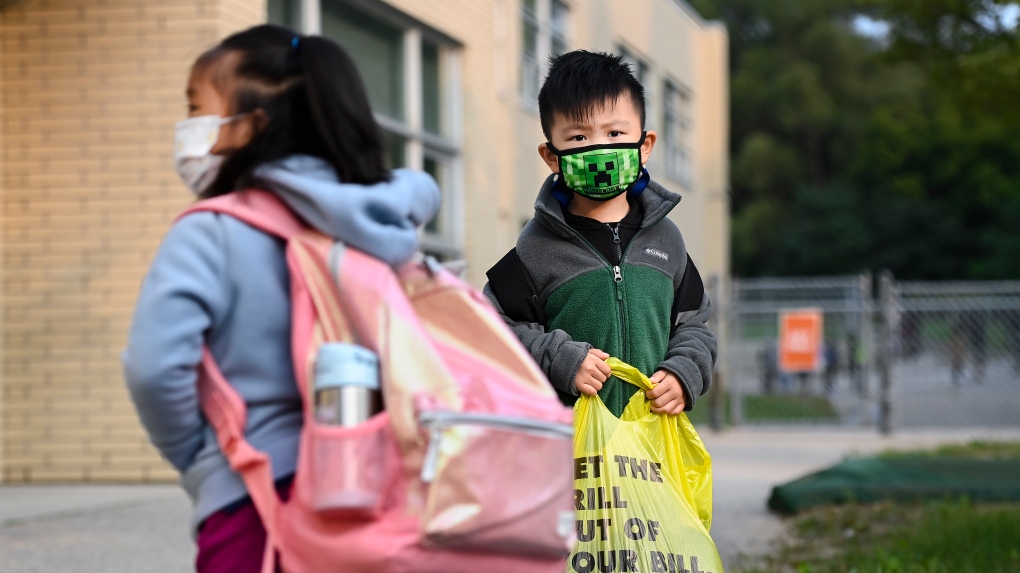Rates of long COVID significantly lower among children compared to adults: Canadian study
 Kindergarten children line up before entering class at Portage Trail Community School which is part of the Toronto District School Board (TDSB), on Tuesday, September 15, 2020. THE CANADIAN PRESS/Nathan Denette
Kindergarten children line up before entering class at Portage Trail Community School which is part of the Toronto District School Board (TDSB), on Tuesday, September 15, 2020. THE CANADIAN PRESS/Nathan Denette
A new study led by Canadian researchers has found that the rates of long COVID among children are substantially lower compared to adults.
The study, titled "Post–COVID-19 condition in children 6 and 12 months after infection," was published in the peer-reviewed journal JAMA Network Open on Thursday and looked at what proportion of children had symptoms that met the definition of long COVID, also known as post-COVID condition. The researchers looked at a cohort of more than 5,000 Canadian children from pediatric emergency departments and followed up with the children after 90 days, six months and 12 months.
The World Health Organization defines pediatric post-COVID condition as having symptoms that develop within three months of a COVID-19 infection, last for at least two months, and "limit everyday function and ascertainment of developmental milestones," the study says.
At the six-month follow-up, six of the 1,152 children with positive tests had symptoms that met the definition of long COVID, while four of the 3,995 children with negative tests met the definition. After 12 months, there were eight of 1,192 children with positive tests and seven of 4,371 children with negative tests who met the definition.
In addition, the researchers also measured any quality-of-life reductions in the children and found that overall quality of life among children who tested positive for COVID-19 didn't significantly differ from those who tested negative.
It's unclear how common long COVID is among adults who become infected with SARS-CoV-2, but according to the researchers, estimates made in various studies range between 7.5 per cent and 45 per cent.
Comparatively, the researchers noted that "very few infected children" develop post-COVID condition, as only 0.67 per cent of the children in the cohort who tested positive met the definition of long COVID.
This is in contrast to some of the previously published research, such as a 2022 study conducted in Germany, which found that the prevalence of "moderate or severe" post-COVID symptoms among adolescent girls was 32 per cent. However, the Canadian researchers note that their study is the first to use the WHO's consensus definition of pediatric post-COVID condition.
The researchers acknowledged a few limitations to their study. Most notably, they said they weren't able to follow up with 30 per cent of the eligible participants, and the children who did participate in the follow-ups were more likely to have been infected by the Omicron variant, which is " less strongly associated" with long COVID. Additionally, 80 per cent of the study participants were under the age of eight, which means the results may be "less generalizable to older children," the researchers wrote.
CTVNews.ca Top Stories

BREAKING Czechia scores late to eliminate Canada from world juniors
Jakub Stancl scored his second goal of the game with 11.7 seconds left in third period as Czechia survived a blown 2-0 lead to defeat Canada 3-2 and advance to the semifinals at the world junior hockey championship on Tuesday.
Canadian couple lives on cruise ships — with no plans to return to land
With 75 countries and territories visited, a retired Canadian couple is making the most of life as they cruise full-time, from coast to coast. They're part of a growing trend of people opting to retire at sea.
Planes catch fire after a collision at Japan's Haneda airport, killing 5. Hundreds evacuated safely
A passenger plane and a Japanese coast guard aircraft collided on the runway at Tokyo's Haneda Airport on Tuesday and burst into flames. Transport Minister Tetsuo Saito confirmed that all 379 occupants of Japan Airlines flight JAL-516 got out safely before the plane was entirely engulfed in flames.
Israeli strike in Lebanon kills senior Hamas official Saleh al-Arouri: security sources
Senior Hamas official Saleh al-Arouri was killed on Tuesday night in an Israeli drone strike on Beirut's southern suburbs of Dahiyeh, three security sources told Reuters.
A missing person with no memory: How investigators solved the cold case of Seven Doe
Police specializing in missing people and cold cases have discovered the identity of a woman with no memory in one of the most unusual investigations the sheriff's office has pursued and one that could change state law.
Weight-loss drugs: Who, and what, are they good for?
Extraordinary demand, and high prices, for powerful weight-loss drugs will keep them out of reach in the coming year for many patients who are likely to benefit.
Woman who fell out of Edmonton city bus dies
A woman who fell out of an Edmonton city bus Friday has died, police said in a media release issued Monday.
Canada's 100 highest-paid CEOs broke new compensation records in 2022: report
Canada's 100 highest-paid CEOs broke records with their compensation in 2022, according to the Canadian Centre for Policy Alternatives.
Russian missiles hit Ukrainian cities, killing 5 and injuring almost 100, Kyiv officials say
Ukraine's two largest cities came under attack from Russian hypersonic ballistic missiles on Tuesday morning, killing at least four people and injuring almost 100, officials said.



























